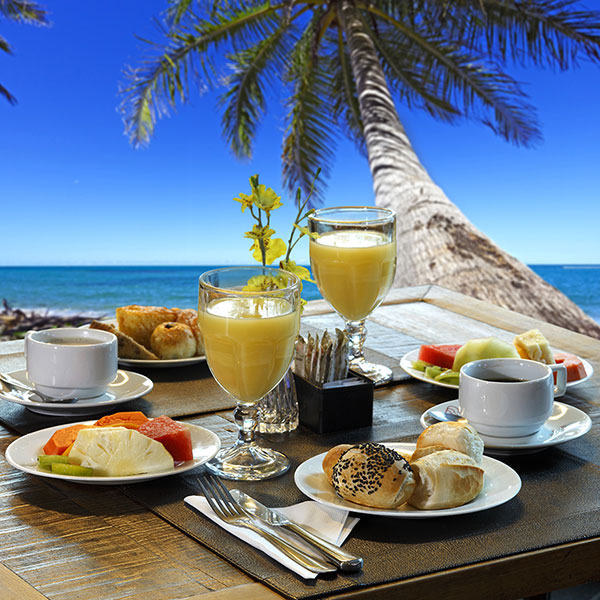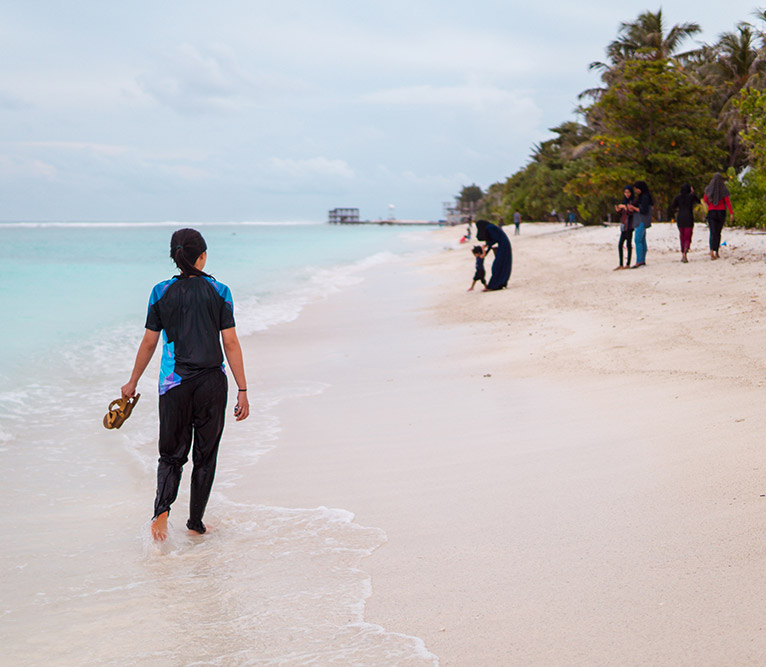Maldives Travel Guide

Marooned on the Indian Ocean, at the top of the equator, the Maldives is made up of a vast underwater mountain range. The prominent tips of the range form over 1200 low-lying islands which are locally known as atolls. Two hundred of them are inhabited, and nearly a hundred have been developed as luxury tourist resorts. Entering the Maldives is relatively easy and hassle-free. All nationalities receive a 30-day visitor's visa on arrival. The geography of the country lets it enjoy year-round tropical weather. The temperature ranges between 26°C – 29°C, and when coupled with the abundance of marine life, and iconic overwater villas, the Maldives becomes the ultimate holiday destination! Go ahead and snorkel without a wetsuit in the warm Maldivian waters.
While the country sprawls across 90,000 square kilometres, only 298 square kilometres of that is dry land. The islands are grouped into the famous double chain of 26 atolls. The Maldives is home to about five per cent of the earth's reefs that add colour to the turquoise waters and paper-white beaches. Manta rays, striped bannerfish, sea turtles, barracudas, zebra and hammerhead sharks, clownfish, tunas, sharks, and even the world's largest fish whale sharks lurk in the deep dark waters of Maldives. The visibility, clarity and temperature of the water place it among the best diving, snorkelling and wave surfing spots in the world. Swim with the stingrays, discover the magnificent underwater caves, and explore the rich and vibrant coral walls when you get down to the reef. Four species of sea turtles nest in the Maldives, namely, green, olive ridley, hawksbill and loggerhead. For all the water lovers, it does not get better than this!

Although scholars and historians believe that the Maldives is an old nation populated over 2500 years ago, not much information shines light upon its ancient history. Wayfarers braved the seas from all around the world to arrive at the crossroads of the Indian Ocean. You guessed it right, at the Maldives. While other travellers stayed for some time and left, some made the island their home. Arab traders stopped at the Maldives, then known as the 'Money Isles', the Maldives produced tremendous quantities of cowry shells, an international currency of the early ages. The first settlers included those from the neighbouring countries of Sri Lanka and Southern India.
The country's culture, traditions and diverse physical traits bear witness that the Maldives was a melting pot of people and cultures and the race itself results from the various waves of settlements over thousands of years. Dhivehi, the Maldivian language is an Indo-Aryan language related to an ancient form of Sinhala, a Sri Lankan language, but with Sanskrit origins. Male, the capital city is more of an experience than a series of must-see points. When in the chaotic bylanes of the capital, the best thing to do is take a stroll and absorb everything Male has to offer.

The Maldivian culture reflects every race in the world, with a strong influence from various cultures on the rim of the Indian Ocean, handed down from generation to generation. The Maldives embraced Islam in 1153 AD. Their music and dance display the influence of East Africa, Arabia and the Indian subcontinent. The art of lacquering wooden ornaments, weaving fine reed mats, and coral carvings enrich the Maldivian crafts. They have also mastered the art of boat building. The traditionally crafted Maldivian boat is known as 'dhoni' that was shaped over centuries.
The cultural highlight of practically every trip to the Maldives is the all-male traditional dance and drum performance known as 'Bodu Beru', which translates to 'big drum'. The amalgamation of ancient and modern, Muslim and secular, and conservative and progressive elements in Maldivian society may be contradictory, but getting to know how locals live day-to-day is a rewarding flip side to meeting the natives working in resorts. One can also say that both life and lifestyle varies between the rural areas in the Maldives and the bigger towns.

The people of Maldives are warm, kind and welcoming. Tourism is the primary source of income, and fishing is the traditional source of livelihood. The Maldives encountered a seismic change in the past ten years since inhabited islands have been opened to tourism, and locals can build their guesthouses, welcoming the backpacker crowd. Island hopping made easy via public ferry, speedboat and domestic flights for almost all budgets. And it is wholly possible to holiday in the Maldives without ever touching cash if you pay via credit card on departure. The Maldives has a reputation as the dreamy holiday destination drawing leisure travellers, families, and newlyweds worldwide. A collection of uber-luxe resorts, from secluded overwater villas, underwater restaurants to back-to-nature infinity pools with the best access to the finest and most bountiful reefs in the country, the Maldives has something for everyone. While the remote regions of Northern Atolls house some of the most extraordinary beaches you will ever come across, the Southern Atolls are home to some of the most impressive luxury resorts.

Inter-island transfer in the Maldives is either fast and expensive or very slow and moderately priced. Speedboat transfers are the standard mode of commute to resorts around the international airport, and the rest is covered by seaplane or by domestic flight. Getting to the Maldives is an adventure in itself — be it the panoramic views of the Indian Ocean where each passing atoll is prettier than the last, or obtaining a certificate for crossing the equator. The Maldives dons perhaps the best beaches globally that it is hard not to become blasé about them. Every resort in the Maldives is a private island which alone is reason enough to bring well over a million people to this hidden paradise in the Indian Ocean every year. The Maldives is a prime luxury destination with a price tag to match. However, all-inclusive resorts provide excellent value for money. While the cluster of elite resorts, which the Maldives is recognized for is afoot, with liveaboards and guest houses in local islands, you can also live the authentic Maldives experience. Each stunning island is unique and offers you various adventures to indulge you.
Cuisine that the Maldives offers derives familiarity from countries in East Asia, East Africa and Arabia. Several dishes imbibe the flavour of the rich spices of India and Sri Lanka. For breakfast, locals swear by 'mashuni' prepared by mixing coconut, onions and chilli with freshly caught tuna. Lobster tastes best when cooked alive that you would not want to miss on, when in the Maldives. If you want to delve further in local delicacies, try fish soup served with lime and rice called 'garudhiya'.
Smoked fish, spicy soup, chicken and vegetable curries with local flavour are delectable. Since yam is one of those few crops that grow on the island, fried yams are naturally quite popular in the Maldives! And the tropical screw-pine fruit used to make ice cream is another must-try. Maldivian black tea is called 'kalhu sai', while Maldivian milk tea is known as 'kiru sai'. Michelin starred–chefs cook your meals at the top end, while the all-you-can-eat buffet system works best at the lower end. The phrase, you get what you pay for is strikingly relevant in the Maldives.

How does one decide on the dreamy Maldives over island-hopping in Seychelles or beach-hopping in Mauritius? Marine life in the Maldives is so profuse you can spot an aqua-menagerie without even dipping your feet in the water. How? Carnival of tropical fishes and hawksbill turtles have been recorded as living around the islands. All resorts have their diving school, and most have access to the house reefs. Go snorkelling in the lagoon, watch an open-air cinema on the beach, or try stand-up paddleboarding at sunrise, or ride those mighty waves.
Or you could simply loll about, sipping Pina Coladas or receiving the Maldivian signature massages. Swim with whale sharks in the south and feed hammerhead sharks at Hammerhead Point in the north. No matter how you go about the day, settle in for one of most transcendently beautiful Maldivian sunsets. And that is not it. In the absence of light pollution, stars shine bright in the night sky and you can see constellations visible from both hemispheres being so close to the equator. The island is a stargazer's delight.

The Maldives is home to an intricate ecosystem. While the law protects several marine species, specific areas have been designated to ensure the conservation of those ecosystems and biodiversity. There are twenty-five protected marine regions in the Maldives, usually popular diving sites where all kinds of fishing activities are prohibited. Baa Atoll that harbours globally significant biodiversity in its numerous reefs is a prominent UNESCO Biosphere Reserve.
Hanifaru Bay, one of the atoll highlights, is recognized as a high biodiversity marine region that attracts endangered aquatic beings such as whale sharks and manta rays. There are nature reserves on islands of various atolls to preserve wetlands and mangroves and protect marine areas. Numerous resorts also administer such conservation programs and foster environmental awareness and care. Travellers are also advised to take care not to stand on, touch, remove or keep corals while snorkelling or diving.

The Maldives is an island destination, with year-round tropical weather. If you plan to visit the Maldives in the dry season, expect a sunny side of the island between December and April. Perfect time to see manta rays swimming in the southern waters, this is also the peak season; hence prices are higher than the rest of the year. Christmas-New Year is the busiest and most expensive period of the peak season. If you plan to visit the Maldives between May and November, it is still warm, but with cloudy skies, high humidity, and a likely rainfall chance. These are also ideal months for surfing, and prices are lower, as well. For divers, the transition months of November and April are suitable due to increased water clarity and better visibility. In lesser words, Maldives is ready whenever you are!
Let us whisk you to the tropical paradise of your dreams. The Maldives delivers not only a luxurious getaway but an experiential vacation. Spend your days sipping a pina colada, indulging in watersports, getting massages under the Maldivian sun and bathing in the luxury of overwater villas. Picturesque islands, crystal clear waters, and uber-luxe hotels make the Maldives an obvious choice for a holiday of a lifetime. Whether your purpose of the visit is a tranquil vacation in a faraway island, a whimsical getaway or a family escapade, the Maldives awards you the chance to savour the sunny side of life by the ocean. Breathe in the fresh salty air, let the waves kiss your toes and let the people and the postcard-perfect landscapes keep you enticed throughout. Guess what is better than reading about an island, what to do and staring at its postcard-perfect pictures? Yes, being there and doing that.
To sun-kissed beaches, skinny-dips, salty sea breeze in your hair and tan lines. Let's go, because somewhere out there is a cocktail on the sundeck and a hammock waiting just for you.